Expert’s Rating
Pros
- Excellent CPU and GPU performance
- Bright, vibrant Mini-LED display
- Good connectivity including Thunderbolt 4 and 2.5G Ethernet
- MSRP is attractive for the performance delivered
Cons
- Unimpressive look and feel
- Mediocre keyboard and small touchpad
- Thick, bulky, and heavy
- Simple webcam and microphone, no biometric login
Our Verdict
The Asus ROG Strix Scar 18 looks mundane, but its performance is something to behold.
Price When Reviewed
$3,899.99
Best Prices Today: Asus ROG Strix Scar 18 (2024)
Desktop replacement. It was once a semi-official category of laptop: it appeared as a filter on retailer websites like Best Buy and Newegg and was referenced in our reviews. The category has since fallen out of favor, but there’s still a rare few laptops that fit that niche. Asus’ ROG Strix Scar 18 is among them. It delivers extreme CPU and GPU performance in a supposedly portable design, powered by both Intel and Nvidia’s most beastly portable hardware, but it’s at its best on a desk.
Looking for pick up a new gaming laptop? Check out PCWorld’s roundup of the best gaming laptops available today.
Asus ROG Strix Scar 18 (2024): Specs and features
The Asus ROG Strix Scar 18 is a high-performance laptop and it pulls out all the stops. It has an Intel Core i9 processor with 24 cores, 32GB of RAM, and Nvidia RTX 4090 graphics with a lofty maximum graphics power of 175 watts. It also has an 18-inch Mini-LED display.
- CPU: Intel Core i9-14900HX
- Memory: 32GB LPDDR5
- Graphics/GPU: Nvidia RTX 4090 with 175-watt maximum graphics power (150 watts + 25 watts Dynamic Boost)
- Display: 2560×1600 240Hz IPS Mini-LED
- Storage: 2TB PCIe Gen4 NVMe solid state drive
- Webcam: 720p HD camera
- Connectivity: 1x Thunderbolt 4 with DisplayPort, 1x HDMI 2.1, 2x USB 3.2 Gen 2 Type-A, 1x USB 3.2 Gen 2 Type-C with Displayport and Power Delivery, 1x 3.5mm audio jack
- Networking: 2.5G LAN, Wi-Fi 6E, Bluetooth 5.3
- Biometrics: None
- Battery capacity: 90 watt-hours
- Dimensions: 15.71 x 11.57 x 1.21 inches
- Weight: 6.83 pounds
- MSRP: $3,899.99
You pay for the hardware, of course, but perhaps not as much as expected. The Asus ROG Strix Scar 18 carries an MSRP of nearly $3,900. That’s a lot, but other rip-roaring performance laptops are most expensive. The MSI Raider 17 is priced at $5,289 on Newegg while an Alienware m18 (with slightly less impressive hardware) will set you back $3,800.
Asus ROG Strix Scar 18 (2024): Design and build quality
IDG / Matthew Smith
The Asus ROG Strix Scar 18 is technically a laptop, but makes little effort to offer a slim, light design. It measures over one inch thick, nearly 16 inches wide, and almost a foot across. That’s beefy. It won’t fit in many laptop bags, even those designed for larger-than-usual laptops, and leaves little tabletop space for your coffee should you tote it to your local Starbucks.
Asus’ design leans into this. A laptop that’s really meant to travel between desks arguably gains less from a rigid chassis or eye-catching looks, so the ROG Strix Scar 18 isn’t a head-turner. It has a simple charcoal chassis adorned by subtle ROG accents.
The laptop’s most alluring design trait is the heavy use of LED accents, which are found on both the display lid and around the laptop’s perimeter. They have some utility. They blink red when charging, for example. But it’s mostly about the vibe and the vibes are good. The LED accents are attractive, well placed, and can be customized through the laptop’s included software or Windows’ Personalization settings.
Build quality, however, is a bit of a miss. There’s nothing wrong, but not much right, which is disappointing for a $3,899.99 laptop. Plastic is the material choice and plenty of flex is felt across both the display lid and the lower chassis. It honestly seems no more sturdy than the sub-$1,000 Acer Nitro V.
Asus ROG Strix Scar 18 (2024): Keyboard, trackpad
IDG / Matthew Smith
A laptop as massive as the Asus ROG Strix Scar 18 should have plenty of space for a large keyboard, but that’s only mostly true here. It provides a reasonably spacious layout overall and adds a numpad, but the numpad keys aren’t full-size and some other keys, such as Control and Shift on the right-hand side of the keyboard, are miniaturized.
Key feel is good with long key travel and a crisp bottoming action, but the ROG Strix Scar 18 doesn’t provide mechanical key switches, a feature found on some other high-end gaming laptops like the MSI Titan 18 HX and Alienware m18. I don’t mind this much, but I’m sure it will disappoint keyboard purists.
A modest touchpad sits quietly below the keyboard. It measures about five inches wide and three inches deep. That’s not bad for a 14-inch laptop but it looks and feels cramped on an 18-inch machine. On the plus side, the touchpad surface is smooth, responsive, and executes multi-touch gestures well.
Asus ROG Strix Scar 18 (2024): Display, audio
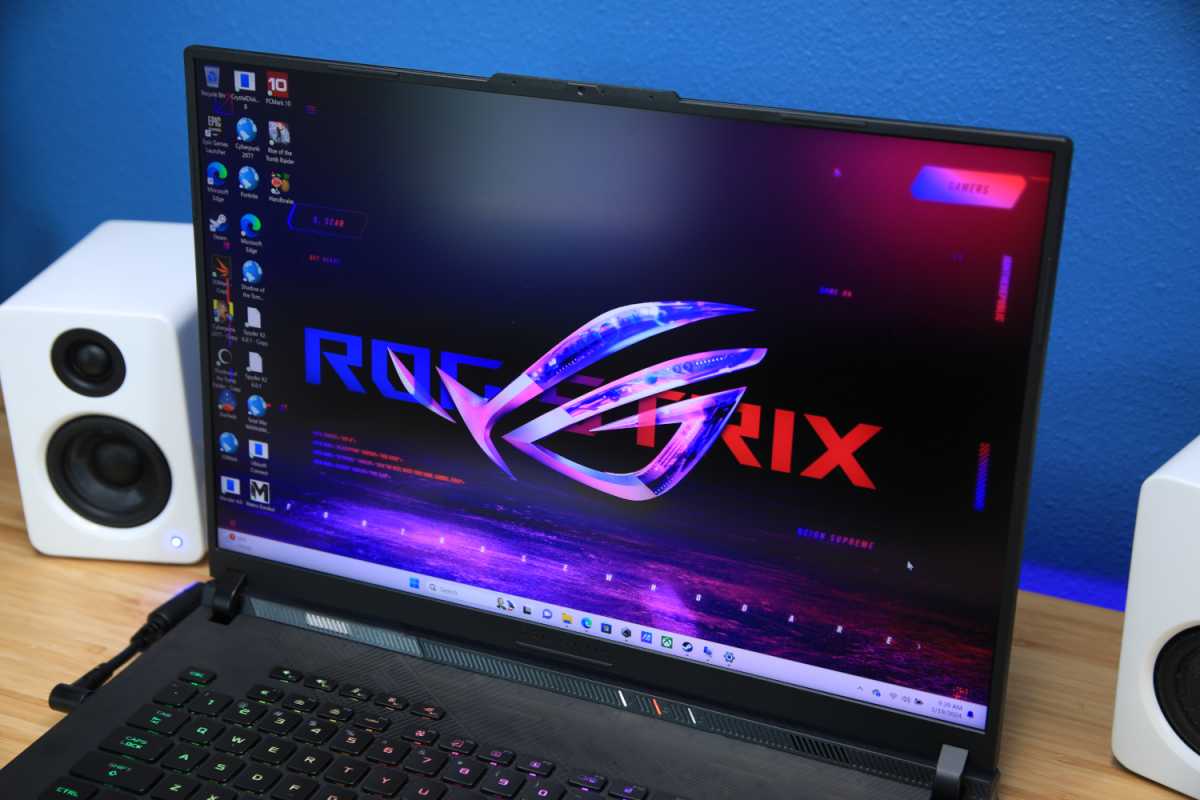
binary comment
IDG / Matthew Smith
The Asus ROG Strix Scar 18’s display is arguably the laptop’s headline feature, and it’s something to behold. We’re talking an 18-inch Mini-LED display with 2,304 dimming zones and a refresh rate of 240Hz.
Delivering a Mini-LED with this many dimming zones radically improves contrast over a typical IPS display as well as most prior Mini-LED laptops. I measured a maximum contrast ratio of 25400:1 at 100 percent of the display’s maximum brightness. At low levels of brightness, the contrast ratio becomes effectively infinite and comparable to OLED.
The display also scores well in color gamut, color accuracy, and maximum brightness. We’re talking a maximum SDR brightness of 532 nits and a maximum HDR brightness of 1153. That’s higher than most HDR computer monitors, and it leads to eye-searing peak brightness in HDR movies and games. When something goes boom, you see it.
Motion clarity and fluidity is excellent thanks to the monitor’s 240Hz refresh rate and support of Nvidia G-Sync. Fast-moving objects retail good detail and fine text remains easy to read in motion. I’ve witnessed better results from OLED displays, but the ROG Strix Scar 18 does well.
It’s not all good news, however. Blooming, an issue with Mini-LED displays that causes bright halos around bright objects on a dark scene, is still evident. I find it’s virtually unnoticeable when viewing movies and games, but it’s more apparent around the edges of apps on the Windows desktop. I noticed it around the Windows desktop cursor when using apps in dark mode, too. There’s also a vignetting effect around the edges of the display, which appears moderately dimmer when bright content is shown. These issues are most visible at higher levels of brightness and when HDR is turned on.
The laptop’s audio unfortunately doesn’t live up to the display. Asus offers a four-speaker system that provides reasonably crisp, rich audio, but it’s not loud. And, despite that, it can still become muddy or metallic when asked to handle music with deep bass or an action-heavy scene. The speakers will do in a pinch, but external speakers or a headset are recommended.
Asus ROG Strix Scar 18 (2024): Webcam, microphone, biometrics
Despite its size, the Asus ROG Strix Scar 18 only finds space for a humble 720p webcam. It’s not great. The camera records soft, blurry, grainy video that looks especially bad blown up across the laptop’s large 18-inch, 2560×1600 screen. Is it fine for Zoom? Sure. But you’re not going to look good.
I was left with a similar impression of the microphone. It works well enough for a quick online meeting, but the presentation is hollow and can make your voice more difficult to understand.
As for biometrics, well, there’s not any. That isn’t too unusual for a gaming monitor, though it would have been nice to see support for Windows Hello facial recognition.
Asus ROG Strix Scar 18 (2024): Connectivity
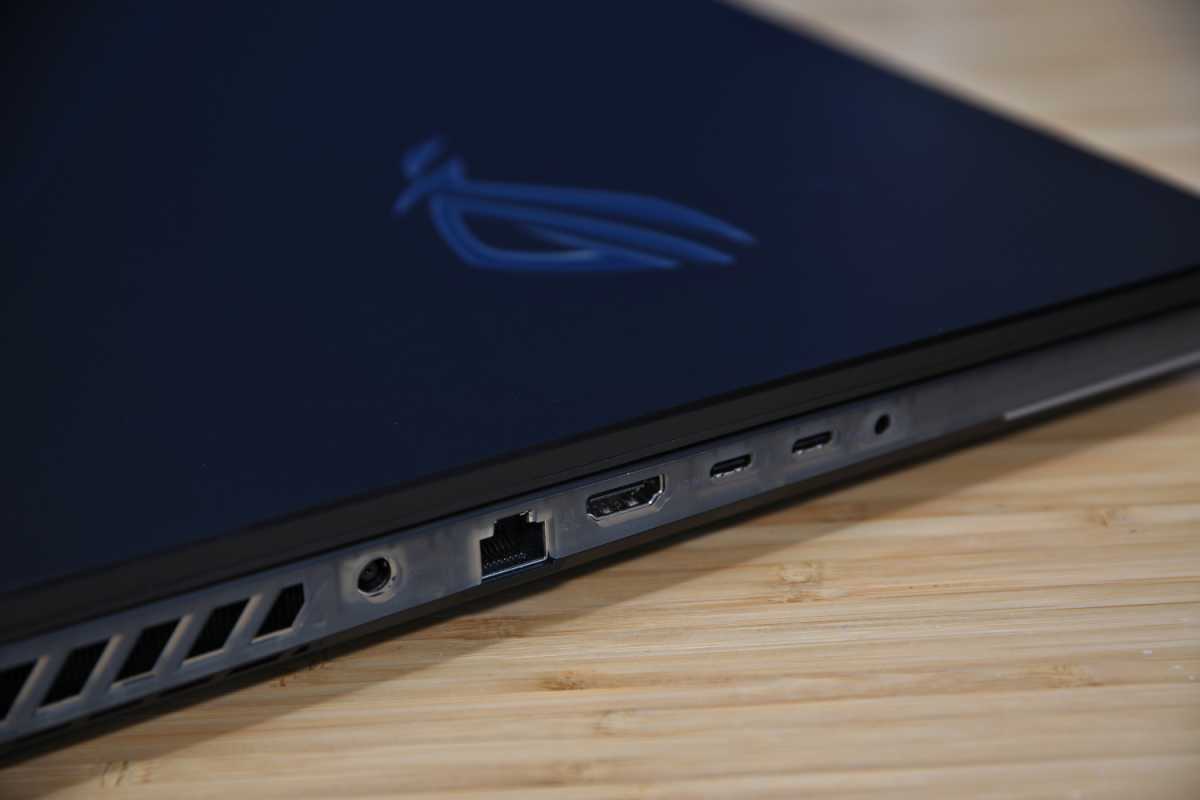
IDG / Matthew Smith
Big laptops have big connectivity, and the Asus ROG Strix Scar 18 is no exception. It provides one Thunderbolt 4 port and one USB-C port, both of which provide power and DisplayPort. There’s also one HDMI 2.1 port with FRL, a pair of USB 3.2 Gen 2 Type-A ports, and a 3.5mm audio jack. It would be nice to also see an SDcard reader or another USB-A port, but there’s gobs of connectivity here.
The same is true of the laptop’s network connectivity. It has a 2.5G wired Ethernet port and supports Wi-Fi 6E alongside Bluetooth 5.3. Wi-Fi 7 is just now beginning to appear in routers, so Wi-Fi 6E is no longer the cutting edge, but I’ve yet to review a laptop with Wi-Fi 7 support. The ROG Strix Scar 18’s network connectivity is as extensive as anyone can expect from a modern gaming laptop.
Power is delivered by a formidable 330 watt power-brick that connects to the laptop’s left flank through a barrel plug adapter. The laptop’s Thunderbolt and USB-C ports support power, as mentioned previously, but it consumes far too much power to supply over these connections. You’ll need to bring the power brick when traveling.
Asus ROG Strix Scar 18 (2024): Performance
Now we come to it—the Asus ROG Strix Scar 18’s real reason for being. Performance is always important for a laptop, of course, but it’s more important for some than for others, and here it’s absolutely critical.
Asus certainly delivers on paper. The ROG Strix Scar 18 I tested had Intel’s Core i9-14900HX, a 24-core, 32-thread processor with eight performance cores, 16 efficient cores, and a maximum Turbo boost of 5.8GHz. It also had Nvidia RTX 4090 mobile graphics with a maximum graphics power of 175 watts. This is top-tier kit. Does it lead to top-tier results?

IDG / Matthew Smith
First up is PCMark 10, a holistic system benchmark that gauges performance across a variety of simulated tasks. The Asus ROG Strix Scar 18 does well in this benchmark with a score of 8,145, but it still ends up behind some other high-performance laptops such as the Acer Predator Triton 17X and MSI Titan GT 77 HX 13V.
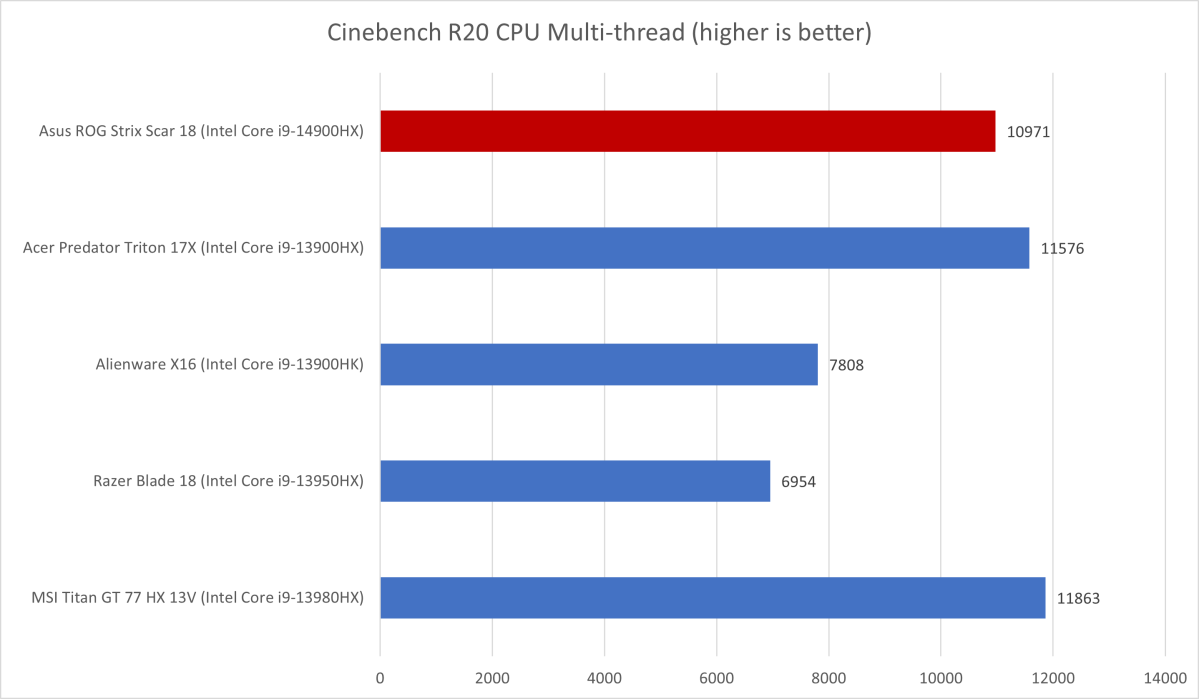
IDG / Matthew Smith
It’s a similar story in Cinebench R20, a heavily multithreaded CPU benchmark. The Asus ROG Strix Scar 18 reaches a score of 10,971, which is excellent, but also just a hair behind other high-performance laptops.
The Razer Blade 18 and Alienware x16 fall back, however, despite powerful hardware. This marks the difference between a laptop wholly focused on performance and one that tries to balance performance with size and weight.
Both the Razer Blade 18 and Alienware X16 can achieve results closer to the ROG Strix Scar 18 if set to their “performance” or “turbo” mode, but that drastically kicks up the fan noise.
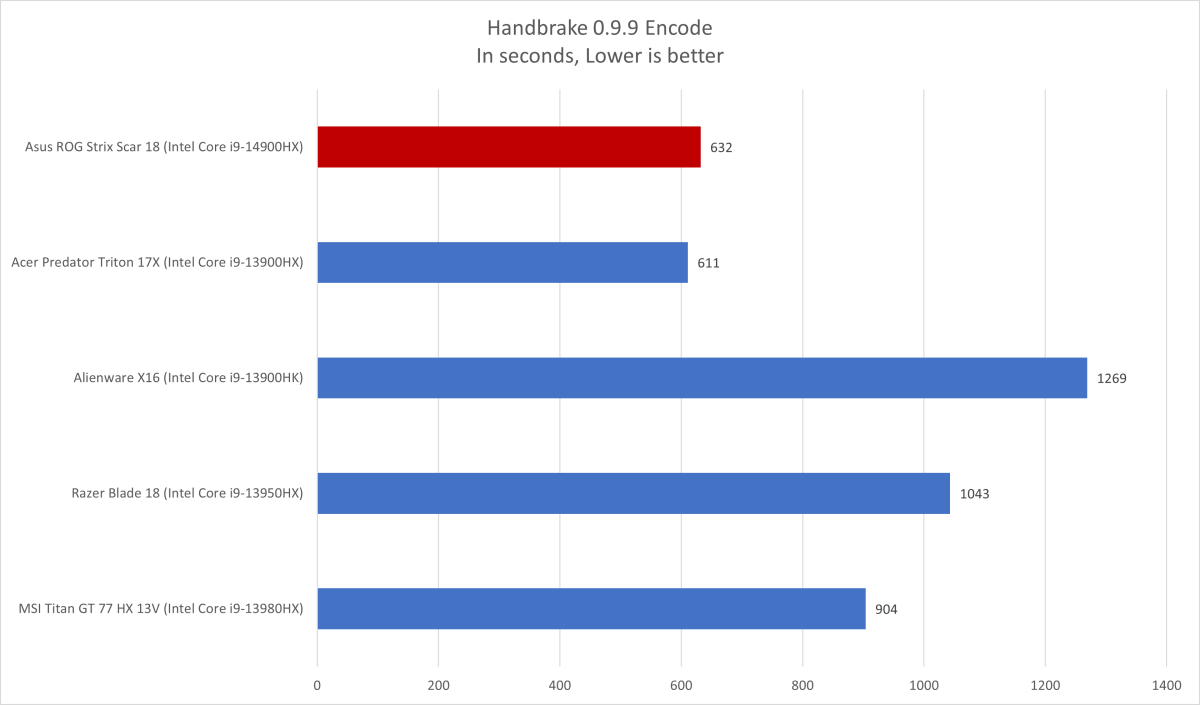
IDG / Matthew Smith
The story continues in Handbrake, a long-duration, heavily multithreaded CPU benchmark. The Asus ROG Strix Scar 18 performs well but doesn’t beat the Acer Predator Triton 17X. The Razer Blade 18 and Alienware X16 again lag behind.
MSI’s Titan GT 77HX 13V is the outlier here. That laptop’s score of 904 felt excellent last spring, but in retrospect it’s lower than I would have expected (it was the first Intel Core i9-13980HX laptop I reviewed and only the second reviewed by PC World).
So, in a nutshell: the Asus ROG Strix Scar 18 is fast, but the Intel Core i9-14900HX doesn’t seem to raise the bar over what was available last year. That’s sure to be a disappointment if you expected a new processor generation to deliver a generational uplift. On the other hand, though, it’s clear that Intel’s Core i9-14900HX is extremely quick.
Now we move on to the laptop’s graphics, where I expect the story of excellent yet stagnant performance will continue. Nvidia’s RTX 4090 mobile graphics is quick, but it’s also fundamentally the same GPU that debuted in high-performance laptops last year.

IDG / Matthew Smith
3DMark Time Spy was an early confirmation of my expectations. The Asus ROG Strix Scar 18 hit a score of 19,262, which is the second best of the laptops I used for comparison. But it’s also behind the MSI Titan GT 77 HX 13V. The ROG Strix Scar 18 is extremely fast, but it’s not setting records.

IDG / Matthew Smith
The order of the rankings varies in Shadow of the Tomb Raider, but the story remains the same. Asus’ ROG Strix Scar 18 achieves an excellent average frame rate of 194 frames per second at 1080p and the Highest detail settings. That’s a stellar result and more than enough to enjoy the game. But it’s not the highest we’ve seen, as the Acer Predator Triton 17X hit 197 frames per second.
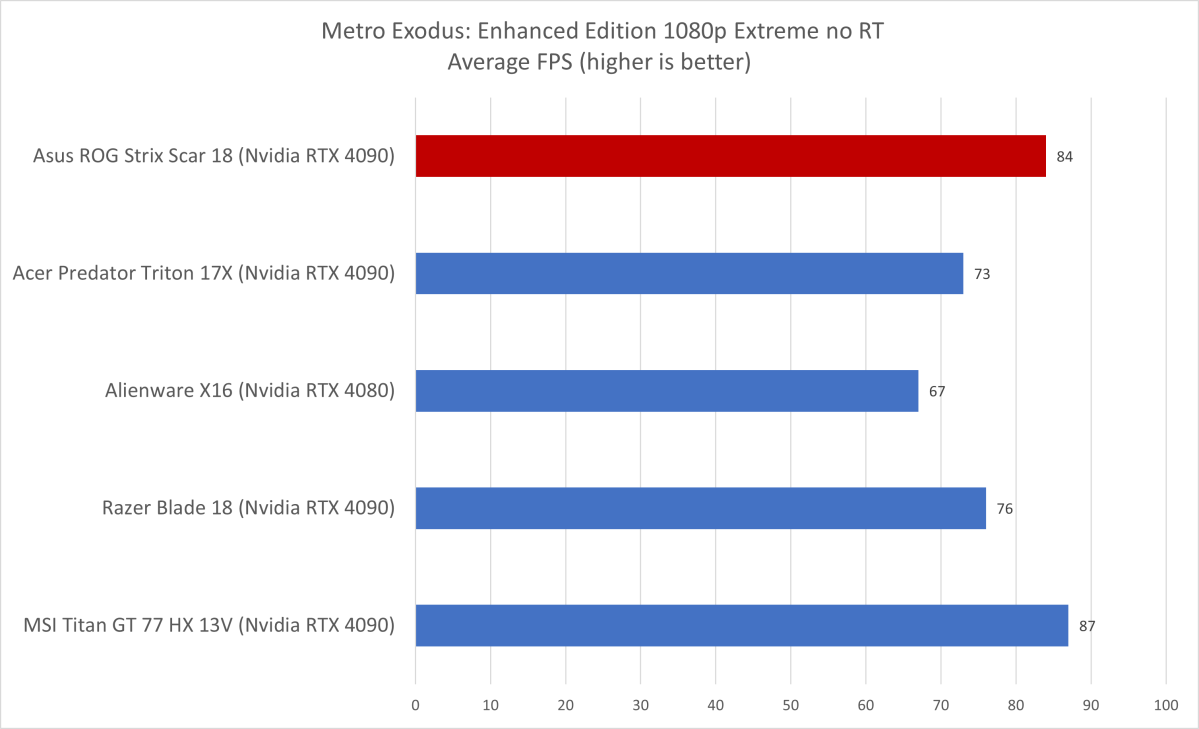
IDG / Matthew Smith
Metro Exodus, a far more demanding game that we test at 1080p and Extreme detail (though without ray-tracing), does nothing to challenge the narrative. The Asus ROG Strix Scar 18 performs extremely well with an average framerate of 84, but it’s not the quickest, losing out to the MSI Titan GT 77 HX 13V.
The Asus ROG Strix Scar 18 includes several power profiles, such as a Turbo mode meant to enable maximum performance. However, these modes didn’t greatly change the laptop’s performance story, with performance gains of five to 20 percent. The largest gain was found in Cinebench R20, where the Turbo mode boosted the ROG Strix Scar 18’s score to 12,415. That’s the second-best score we’ve recorded in that test.
Competitors also have a Turbo or Performance mode, however, and the ROG Strix Scar 18’s general standing against its competitors doesn’t change when the mode is enabled. All of the test results shown above were captured in each laptop’s default performance profile.
So, what’s the verdict on the Asus ROG Strix Scar 18’s performance?
Those who expect new hardware to deliver performance gains will be disappointed, because that’s not what happened here. The Asus ROG Strix Scar 18 is extremely fast in all benchmarks but never raises the bar. It’s more or less the same as the quickest laptops from 2023.
Yet the laptop’s performance is extremely strong in absolute terms. It may not set records, but it’s very close to setting records in every benchmark, and it absolutely demolishes smaller, thinner laptops. Choosing the Asus ROG Strix Scar 18 over a thinner machine like the Razer Blade 18 will net you a performance gain overall, and it’s in an entirely different league than a 16-inch laptop like the Alienware X16.
Personally, I lean more towards the second perspective, which means I remain impressed. The Asus ROG Strix Scar 18 is a fast laptop. It’s also rather affordable for the performance it delivers. $3,900 isn’t cheap, but you could spend a lot more. Still, those who already own a high-performance laptop built in the last few years don’t need to rush out and buy the ROG Strix Scar 18.
Asus ROG Strix Scar 18 (2024): Battery life
Asus ships the ROG Strix Scar 18 with a 90 watt-hour battery. That’s large, but it’s not the largest a laptop of this size can have (some laptops have batteries up to 99 watt-hours). A laptop this powerful will of course tax any modern battery, but its endurance is a tad better than might be expected.
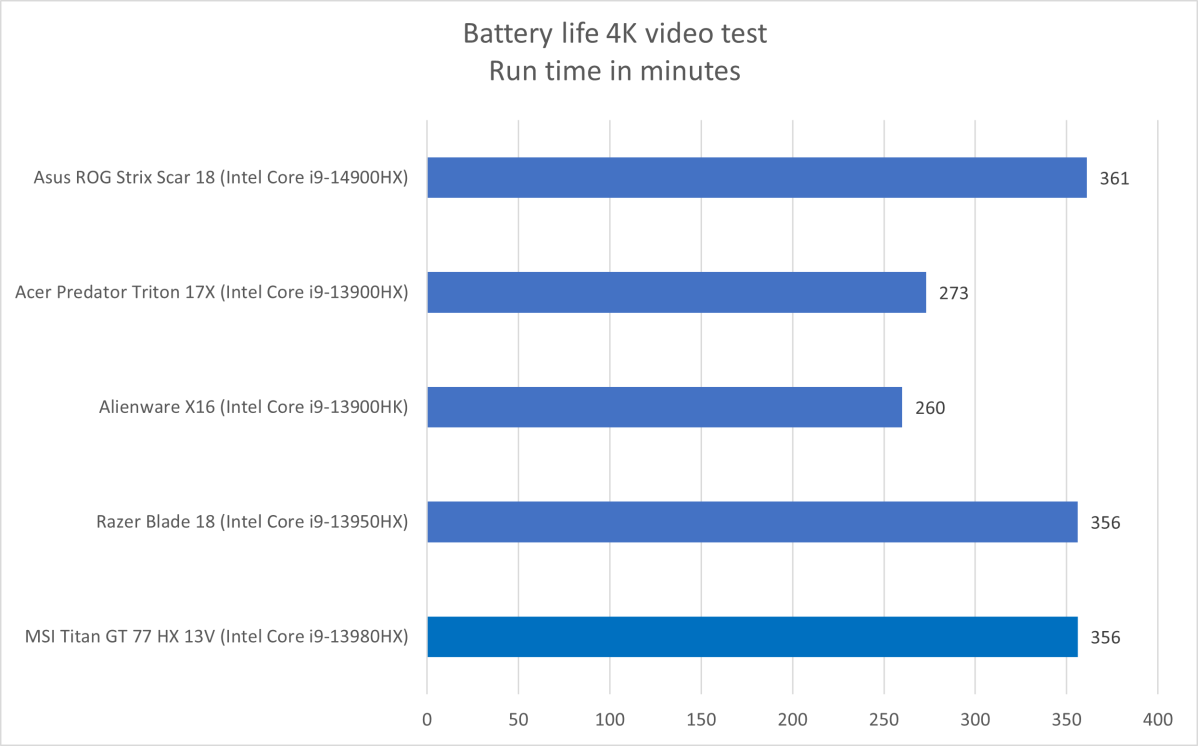
IDG / Matthew Smith
I recorded six hours and one minute of battery life in our standard battery test, which loops a 4K file of the short film Tears of Steel. Six hours isn’t amazing but, as visible on the graph, it’s competitive with other high-performance laptops.
Keep in mind, however, that our battery test places the system under a light load. The ROG Strix Scar 18 also has Nvidia Optimus, which saves power by disabling the RTX 4090 when its performance is unnecessary. A modern 3D game will chew through the battery far more quickly.
Asus ROG Strix Scar 18 (2024): Conclusion
The Asus ROG Strix Scar 18 is not quite what it might seem at a glance.
I suspect most shoppers will see its nearly $3,900 MSRP and think it a competitor to the MSI Titan 18 or Razer Blade 18. That’s only partially true. The ROG Strix Scar 18 is a high-performance laptop yet, unlike those alternatives, it sticks to a thick, bulky, conventional design. It’s not a looker and it doesn’t feel luxurious, but the ROG Strix Scar 18 delivers on performance for the price.


